In 1900 Pablo Picasso was still only 18 years old but his prodigious talent was already acknowledged so much so that he was selected to represent Spain at the Universal Exhibition in Paris. This was also the year Picasso made his first trip to Paris and between 1900 and 1904 he moved between both Paris and Spain until in 1904 he finally decided to settle in Paris. These years, together with the subsequent two, saw many developments and changes in his style and the exhibition Picasso:Blue and Rose at the Musée D’Orsay is a unique opportunity to follow this evolution. The exhibition brings together a dazzling array of masterpieces from all around the globe giving the visitor a fascinating overview of Picasso’s experimental journey over this six year period.
The changes in styles over the period were radical and the exhibition cleverly presents at the outset three self portraits, below, each reflecting Picasso’s style at the time of their creation.
The first self portrait which he signed Yo, Picasso (I, Picasso), shows a confident, almost arrogant, Picasso at the time of his second trip to Paris in 1901 when he had his first exhibition at the gallery of the influential art dealer Ambrose Vollard and where this self portrait was presented. The second self portrait is clearly a product of his famous Blue Period. This period was influenced by the suicide of his friend Carlos Casagemas which began late in 1901 and lasted until 1904. Picasso’s Rose Period followed and by the end of 1906 he was working with a reduced ochre palette and creating more simplified forms where facial features were reduced to mask like shapes as reflected in his own self portrait of the same year.
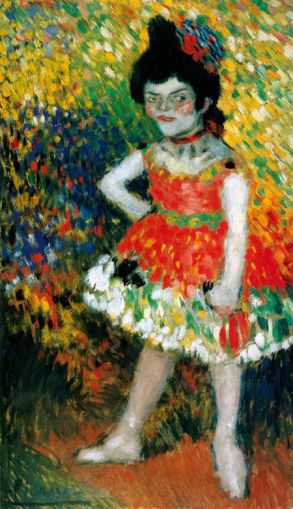
In the run up to the Vollard exhibition Picasso was producing a body of work dominated by vibrant colours. Much of his subject matter was taken from Parisian night life but he also harked back to the works of Spain’s Old Masters which he had studied as a teenager in Madrid. In his painting La Naine (or Dwarf Dancer), painted in 1901, Picasso shows his debt to Velazquez (1599-1660), by his choice of subject matter as Velazquez regularly painted the dwarfs at the Court of King Philip IV. However, by 1901, Picasso had freed himself from academic restraints and in La Naine one also sees the influences of the great artists of the modern era such as Degas, Van Gogh and Toulouse Lautrec. La Naine (or Dwarf Dancer) depicts a ballet dancer, a favourite theme of Degas, in a red tutu who Picasso has set against a dazzling background of yellows, greens and blues executed in broken brush strokes giving an energy to the image despite the somewhat static stance and harsh expression of the dancer.
Another reworked theme by Picasso around this time, and one which had previously been explored by Degas, Toulouse Lautrec and Van Gogh, is the café-goer, either alone or as a couple sitting at a table. In many of his paintings, Picasso showed the café-goer as an absinthe drinker such as the one below, absinthe being a very popular drink in France at the time. In The Absinthe Drinker, 1901, Picasso has chosen to depict the moment when this solitary looking drinker is about to add a cube of sugar to the absinthe drink which sits before her on the table. She appears all dressed up wearing a bright red scarf with matching coloured lipstick yet she cuts a lonely image as she sits alone appearing engrossed in her her own thoughts.
Above from left to right : The Absinthe Drinker, 1901, Private Collection and Seated Harlequin, 1901, The Metropolitan Museum, New York.
The Harlequin character was a well known figure in popular culture in Paris in 1901 and in Seated Harlequin, Picasso has placed him in the café going culture of the time. His Harlequin poses elegantly on a green couch with one hand resting on the seat and the other with elbow resting on the table with fingers posed on his face. His costume is painted in blue and black squares set off with white ruff-like cuffs and collar. Harlequin’s white painted face is turned away from both the table and the viewer and gazes pensively downwards giving a theatrical feel to the image.
Picasso’s exhibition at Vollard’s was considered a success with reviews such as the one in La Justice describing Picasso as ‘offering something novel’ and having ‘gifts of very rare originality’. However, all was not well with Picasso and the suicide of his friend Casagemas in the spring of 1901 haunted him until finally by the autumn he began painting in blue.
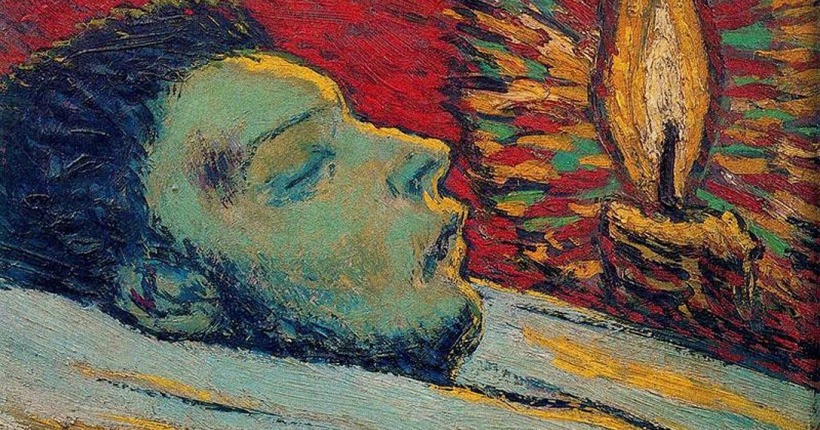
Picasso continued painting with a monochromatic palette of shades of blue and blue-green until 1904 reflecting his melancholy at Casagemas death and also the poverty stricken circumstances that he now found himself in. During his Blue Period, Picasso painted scenes of poverty, alienation and misery as is evidenced by the selection below of Blue Period works on show at the exhibition. The viewer cannot but be touched by the sadness of these evocative paintings which Picasso has brilliantly composed.
Above from left to right, 1. The Crouching Woman, Art Gallery Of Ontario, Canada, 2. The Blind Man’s Meal, Metropolitan Museum Of Art, New York, 3. Mother and Child by the Sea, Palo Museum of Art, Japan, and 4. The Soup, Art Gallery of Ontario, Canada.
The culmination of the Blue Period brings us to the monumental canvas of La Vie, painted by Picasso in 1903 in Barcelona. X-rays have shown that it was painted over Last Moments, the painting Picasso exhibited in 1900 at the Universal Exhibition in Paris. No one is sure of its meaning but it has been suggested that it represents the cycle of life with the pregnant woman portraying life and the crouching man in the centre portraying death. The standing man is Casagemas, who by now has been dead for two years, and the cloaked woman on the right appears in many blue period paintings. Does she hold the child that might have been Casagemas’? Whatever the meaning of the painting, it was well received and fortunately for Picasso, who was having little financial success, found an immediate buyer.
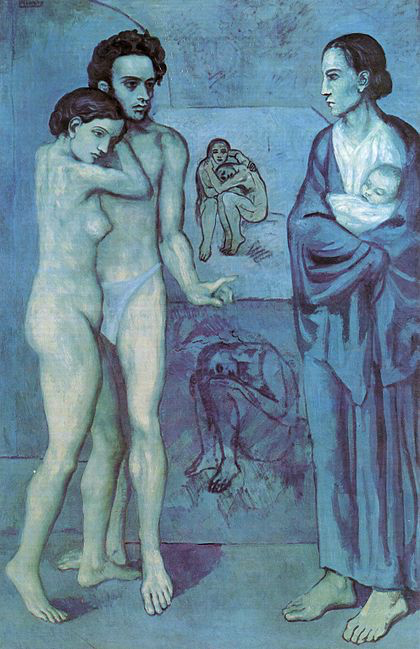
In early 1904 Picasso decided to settle in Paris and he took up residence in the Bateau Lavoir in Montmartre. The Bateau Lavoir was a run down ramshackle old building but it became an artistic hub attracting painters and poets alike. In this bohemian enclave, the clouds started to lift and Picasso’s palette began to expand to include shades of pink, hailing the dawn of the Rose Period. Also around this time he started a relationship with a model known as Madeline who is the subject matter of Girl in a Chemise, which although dated 1905 was begun in 1904.
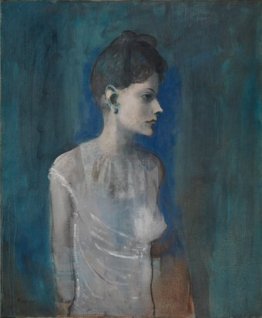
Here one can clearly see the blurring of the Blue and Rose Periods with the blue background including shades of brown and the model’s flesh and lips tinged with pink. Over the next two years not only would Picasso switch from predominantly painting in shades of blue to pink, he would also move away from the sombre themes of the Blue Period, to lighter ones mainly that of the circus. These circus scenes generally captured not the moment of performance but rather the private introspective moments of the lives of the performers as can be noted in the two images below Family Of Acrobats with Monkey and Young Acrobat balancing on a Ball.

As 1905 became 1906, there was a further shift in Picasso’s work with his figures becoming more sculptural. This nod to ‘classicism’ was probably inspired by Ingres whose work had appeared at the Salon d’Automne of 1905. Boy Leading a Horse is a wonderful example of this new shift to a modern vision of classicism, a painting whose meaning is unclear but whose impact is striking. Other influences began to pervade Picasso’s work such as the archaic Iberian sculpture he saw in the Louvre as well as his interest in primitive art. Cezanne’s influence also becomes apparent especially his stocky figures from his Bathers series. Picasso’s palette also began to shift with a move towards ochre tones particularly following his four month trip from May to August 1906 to Gosol, a remote village in the Catalan Pyrenees. Here, away from Paris, he began to truly experiment in a quest for a new pictorial vision and he drew on these influences to create a radical change in style. He also drew inspiration from his girlfriend Fernande Olivier who accompanied him on the trip and who appears in many of his paintings of this period.

The exhibition ends with Two Nudes which was painted in the autumn/winter of 1906 after Picasso’s return from Gosol and demonstrates the ground breaking results of Picasso’s experiments over the previous six years. Here the monumentality of the figures, inspired by the stocky figures of Cezanne’s bathers, compares sharply with the waif like figures of earlier works. The facial features of the nude on the left have taken on the form of a mask as inspired by Picasso’s interest in primitive art. The figure on the right is strange with her breast oddly positioned. Again, the meaning of the painting is not known but with it Picasso heralds his new pictorial vision and is on his way to becoming one of the greatest artist of the twentieth century. He is only 25 years old.
This truly is an amazing exhibition giving the viewer a rare opportunity to see some of Picasso’s best works over this six year period. The images included here do not do justice to the works and for a true appreciation of these masterpieces a visit to the exhibition is a must. It runs until the 6th January 2019 at the Musée D’Orsay, Paris and then it moves to Foundation Beyeler, Riehen, Switzerland from 3rd February until 26th May 2019.










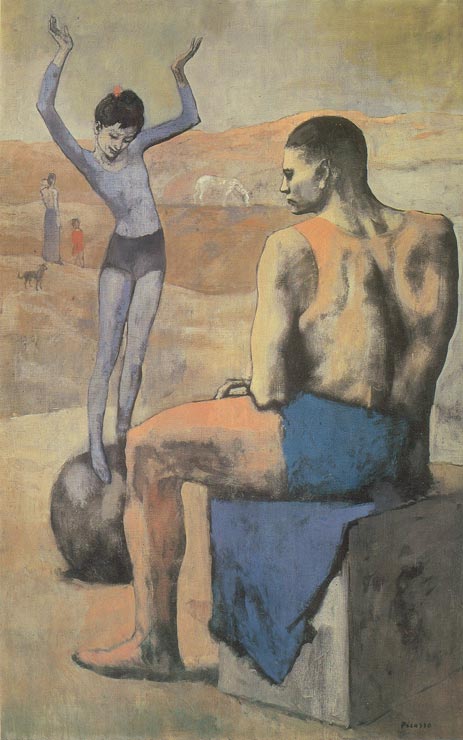
Wow this looks amazing! I’ll have to go take a look for myself and use this as my tour guide!
LikeLiked by 1 person
Yes it was stunning and you definitely should go… book online in. advance to avoid the long queues!
LikeLike